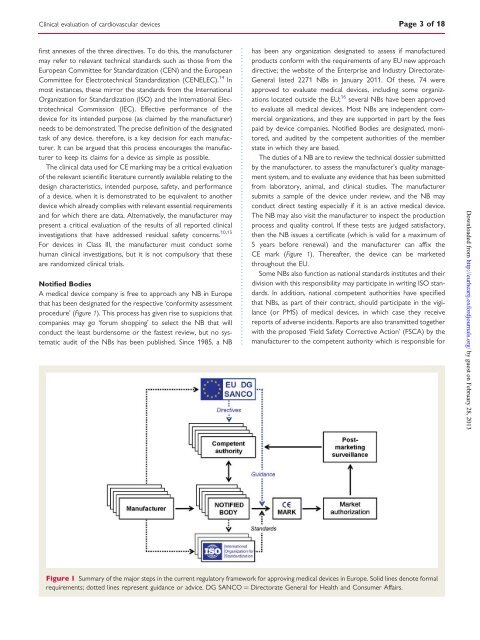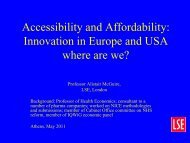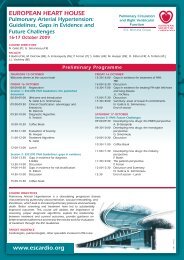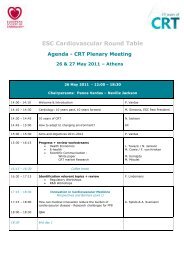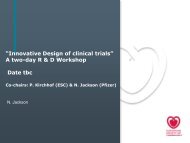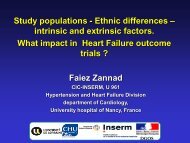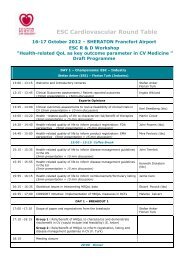ESC Position on Medical Devices - Cardiovascular Round Table ...
ESC Position on Medical Devices - Cardiovascular Round Table ...
ESC Position on Medical Devices - Cardiovascular Round Table ...
Create successful ePaper yourself
Turn your PDF publications into a flip-book with our unique Google optimized e-Paper software.
Clinical evaluati<strong>on</strong> of cardiovascular devices Page 3 of 18first annexes of the three directives. To do this, the manufacturermay refer to relevant technical standards such as those from theEuropean Committee for Standardizati<strong>on</strong> (CEN) and the EuropeanCommittee for Electrotechnical Standardizati<strong>on</strong> (CENELEC). 14 Inmost instances, these mirror the standards from the Internati<strong>on</strong>alOrganizati<strong>on</strong> for Standardizati<strong>on</strong> (ISO) and the Internati<strong>on</strong>al ElectrotechnicalCommissi<strong>on</strong> (IEC). Effective performance of thedevice for its intended purpose (as claimed by the manufacturer)needs to be dem<strong>on</strong>strated. The precise definiti<strong>on</strong> of the designatedtask of any device, therefore, is a key decisi<strong>on</strong> for each manufacturer.It can be argued that this process encourages the manufacturerto keep its claims for a device as simple as possible.The clinical data used for CE marking may be a critical evaluati<strong>on</strong>of the relevant scientific literature currently available relating to thedesign characteristics, intended purpose, safety, and performanceof a device, when it is dem<strong>on</strong>strated to be equivalent to anotherdevice which already complies with relevant essential requirementsand for which there are data. Alternatively, the manufacturer maypresent a critical evaluati<strong>on</strong> of the results of all reported clinicalinvestigati<strong>on</strong>s that have addressed residual safety c<strong>on</strong>cerns. 10,15For devices in Class III, the manufacturer must c<strong>on</strong>duct somehuman clinical investigati<strong>on</strong>s, but it is not compulsory that theseare randomized clinical trials.Notified BodiesA medical device company is free to approach any NB in Europethat has been designated for the respective ‘c<strong>on</strong>formity assessmentprocedure’ (Figure 1). This process has given rise to suspici<strong>on</strong>s thatcompanies may go ‘forum shopping’ to select the NB that willc<strong>on</strong>duct the least burdensome or the fastest review, but no systematicaudit of the NBs has been published. Since 1985, a NBhas been any organizati<strong>on</strong> designated to assess if manufacturedproducts c<strong>on</strong>form with the requirements of any EU new approachdirective; the website of the Enterprise and Industry Directorate-General listed 2271 NBs in January 2011. Of these, 74 wereapproved to evaluate medical devices, including some organizati<strong>on</strong>slocated outside the EU; 16 several NBs have been approvedto evaluate all medical devices. Most NBs are independent commercialorganizati<strong>on</strong>s, and they are supported in part by the feespaid by device companies. Notified Bodies are designated, m<strong>on</strong>itored,and audited by the competent authorities of the memberstate in which they are based.The duties of a NB are to review the technical dossier submittedby the manufacturer, to assess the manufacturer’s quality managementsystem, and to evaluate any evidence that has been submittedfrom laboratory, animal, and clinical studies. The manufacturersubmits a sample of the device under review, and the NB mayc<strong>on</strong>duct direct testing especially if it is an active medical device.The NB may also visit the manufacturer to inspect the producti<strong>on</strong>process and quality c<strong>on</strong>trol. If these tests are judged satisfactory,then the NB issues a certificate (which is valid for a maximum of5 years before renewal) and the manufacturer can affix theCE mark (Figure 1). Thereafter, the device can be marketedthroughout the EU.Some NBs also functi<strong>on</strong> as nati<strong>on</strong>al standards institutes and theirdivisi<strong>on</strong> with this resp<strong>on</strong>sibility may participate in writing ISO standards.In additi<strong>on</strong>, nati<strong>on</strong>al competent authorities have specifiedthat NBs, as part of their c<strong>on</strong>tract, should participate in the vigilance(or PMS) of medical devices, in which case they receivereports of adverse incidents. Reports are also transmitted togetherwith the proposed ‘Field Safety Corrective Acti<strong>on</strong>’ (FSCA) by themanufacturer to the competent authority which is resp<strong>on</strong>sible forDownloaded from http://eurheartj.oxfordjournals.org/ by guest <strong>on</strong> February 28, 2013Figure 1 Summary of the major steps in the current regulatory framework for approving medical devices in Europe. Solid lines denote formalrequirements; dotted lines represent guidance or advice. DG SANCO ¼ Directorate General for Health and C<strong>on</strong>sumer Affairs.


